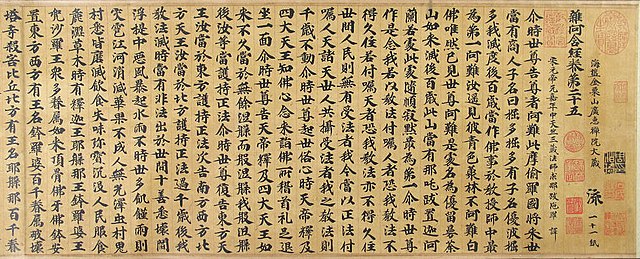Faxian, also referred to as Fa-Hien, Fa-hsien and Sehi, was a Chinese Buddhist monk and translator who traveled by foot from China to India to acquire Buddhist texts. Starting his arduous journey about age 60, he visited sacred Buddhist sites in Central, South, and Southeast Asia between 399 and 412 CE, of which 10 years were spent in India.
An honorary Faxian statue in a Singapore museum.
12th-century woodblock print, 1st page of the Travels of Faxian (Record of the Buddhist Countries). The first sentences read: "In Chang'an, Faxian was distressed that the Vinaya collections was incomplete, so in the 2nd year of Hóngshǐ, or jǐ-hài in the sexagenary cycle [year 399/400], he agreed with Huijing, Daozheng, Huiying and Huiwéi to go seek out more of the Vinaya in India.
Fa Hien at the ruins of Ashoka palace
Faxian's route through India
Buddhist texts are religious texts that belong to, or are associated with, Buddhism and its traditions. There is no single textual collection for all of Buddhism. Instead, there are three main Buddhist Canons: the Pāli Canon of the Theravāda tradition, the Chinese Buddhist Canon used in East Asian Buddhist tradition, and the Tibetan Buddhist Canon used in Indo-Tibetan Buddhism.
Illustrated Sinhalese covers and palm-leaf pages, depicting the events between the Bodhisattva's renunciation and the request by Brahmā Sahampati that he teach the Dharma after the Buddha's awakening
Illustrated Lotus Sūtra from Korea; circa 1340, accordion-format book; gold and silver on indigo-dyed mulberry paper
Folio from a manuscript of the Aṣṭasāhasrikā Prajñāpāramitā Sūtra depicting Shadakshari Lokesvara, early 12th century, opaque watercolor on palm leaf
Samyutagama Sūtra, Medieval China, 11th century








